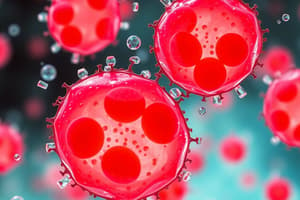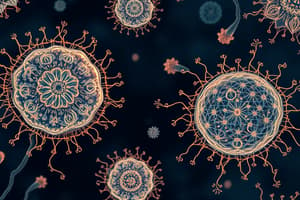Podcast
Questions and Answers
What is the primary function of mitochondria in eukaryotic cells?
What is the primary function of mitochondria in eukaryotic cells?
- Waste destruction
- Cellular packaging
- Energy production (correct)
- Protein synthesis
Which component of the cell membrane is involved in creating a selective barrier?
Which component of the cell membrane is involved in creating a selective barrier?
- Hydrophobic tail (correct)
- Nuclear membrane
- Cytoplasm
- Hydrophilic head
What is the primary role of lysosomes in eukaryotic cells?
What is the primary role of lysosomes in eukaryotic cells?
- Digesting waste materials (correct)
- Translating proteins
- Synthesizing fats
- Energy production
Which type of endoplasmic reticulum is primarily involved in fat synthesis?
Which type of endoplasmic reticulum is primarily involved in fat synthesis?
What crucial function do Golgi apparatus perform in eukaryotic cells?
What crucial function do Golgi apparatus perform in eukaryotic cells?
What distinguishes mature red blood cells from immature red blood cells?
What distinguishes mature red blood cells from immature red blood cells?
What term describes the living content of the cell that is surrounded by a plasma membrane?
What term describes the living content of the cell that is surrounded by a plasma membrane?
How are organelles in eukaryotic cells generally categorized?
How are organelles in eukaryotic cells generally categorized?
What does the term 'cytoskeleton' refer to in eukaryotic cells?
What does the term 'cytoskeleton' refer to in eukaryotic cells?
Which statement accurately describes the nuclear membrane?
Which statement accurately describes the nuclear membrane?
Flashcards are hidden until you start studying
Study Notes
Eukaryotes and Prokaryotes
- Eukaryotes are characterized by the presence of a nucleus, a membrane-bound organelle, which separates genetic material from the cytoplasm.
- Prokaryotes lack a nucleus and membrane-bound organelles.
Organelles
- Organelles are small structures within cells that perform specific functions.
- Unlike organs, which are larger systems composed of many cells (e.g., liver, pancreas), organelles are microscopic subunits with specialized tasks.
Protoplasm
- Protoplasm is defined as the living content of the cell, including both the cytoplasm and nucleoplasm.
- It is surrounded by the plasma membrane, which regulates what enters and leaves the cell.
Membrane Structure
- The plasma membrane consists of a phospholipid bilayer, with hydrophilic (water-attracting) heads facing the aqueous environment and hydrophobic (water-repelling) tails facing inward.
- Cellular membranes are structured with an outer membrane, inner membrane, and intermembrane space, as seen in mitochondria and the nuclear membrane.
Genetic Material
- The nucleus contains genetic material organized into chromosomes, which is crucial for cell function and reproduction.
Cytosol and Diffusion
- Cytosol, the fluid component of the cytoplasm, facilitates the diffusion of molecules throughout the cell.
Key Organelles and Their Functions
- Mitochondria: Known as powerhouses of the cell, providing energy.
- Lysosomes: Function as the cell's cleanup crew, breaking down waste materials and cellular debris.
- Endosomes: Act as delivery mechanisms, packaging and transporting cellular products.
- Endoplasmic Reticulum (ER): Exists as rough ER (involved in protein synthesis) and smooth ER (responsible for lipid synthesis).
- Golgi Apparatus: Sorts and modifies cellular products for distribution.
- Peroxisomes: Enzyme-rich organelles that help detoxify harmful substances, akin to personal trainers for the cell.
Cytoskeleton
- The cytoskeleton provides structural support to the cell, analogous to a skeleton in multicellular organisms.
Function and Adaptation
- Cellular structures are often adapted to their specific functions; for instance:
- Sperm cells require energy and thus have numerous mitochondria.
- Islets of Langerhans in the pancreas, responsible for hormone secretion, contain abundant Golgi apparatus and ER.
- Mature red blood cells lack organelles and a nucleus to maximize space for oxygen transport, while immature red blood cells contain a nucleus.
Summary of Organelles
- Mitochondria: Energy production.
- Lysosomes: Waste destruction.
- Endosomes: Packaging and delivery.
- Rough ER: Protein translation.
- Smooth ER: Fat synthesis.
- Golgi Apparatus: Modifying and sorting products.
- Peroxisomes: Detoxification and metabolic processing.
Studying That Suits You
Use AI to generate personalized quizzes and flashcards to suit your learning preferences.




